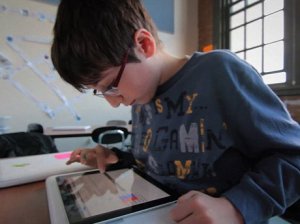Mixing it Up with Mangahigh: Using Games to Differentiate Instruction
Guest blogger Kristof Mueller, a teacher at Quest to Learn, uses the online math game site Mangahigh to illustrate three tips for differentiated instruction: pre-assessment, formative assessment, and the Goldilocks Principle of ‘just right.’
Education doesn't work with a one-size-fits-all approach. Teaching requires a deep understanding of the differences -- in knowledge, abilities, and learning styles -- that students bring to class. Differentiated instruction is the umbrella term describing the many ways that teachers modify their curriculum to meet the needs of all their students.
At Quest to Learn, we take a cue from games when it comes to differentiating instruction. A well-designed game leads players through carefully-leveled tasks that prepare them to succeed in bigger challenges. In my eighth grade math class, I've found that a game can be a powerful and practical tool to help me differentiate instruction. Games can also offer insight into best practices for curriculum design to support all kinds of learners.
One resource I've found especially useful is Mangahigh, a website with a suite of quality math games and engaging skills practice. Between Mangahigh's games and their adaptive quiz engine called Prodigi, the site offers teachers an array of opportunities to differentiate learning activities for their students.

How can teachers use games like Mangahigh to differentiate? And what can teachers learn from game designers when it comes to differentiation? Here are three tips to better differentiate instruction in your classroom, using examples from my experience.
Tip #1: Pre-Assessment - Know What Your Students Know and Can Do
As a teacher in a differentiated classroom, you need to have a clear understanding of what your students already know, what they are ready to learn next, and how they learn best. Do they want to compete or cooperate? Are they visual or kinesthetic learners? What is the best way to give feedback?
The most effective method of gaining this familiarity with students is through pre-assessment. Before beginning a unit of instruction, plan an activity that gives you data about what students are bringing to the table.
For example, I have used Mangahigh's Tangled Web game to pre-assess my students. In this game, the player uses properties of angles to create a path for a spider to safely escape an electrified gear. Prior to my unit on angle relationships, I will challenge students to play this game and achieve a certain level of proficiency. Mangahigh offers a lot of control in their teacher dashboard -- I can assign my students to develop an in-game skill that is a prerequisite for what I'm about to teach.
While the students are playing, I will note which ones are struggling with the prior knowledge, and which ones quickly master it and are ready to move on. Using my notes and Mangahigh's teacher reports, I'm ready to plan lessons that precisely target the needs of the majority of students. I can also plan interventions for those who need them, and challenges for those who are ready.
Tip #2: Formative Assessment - Know Your Curriculum
Intimate knowledge of your content area is a key component to a differentiated classroom. When designing any given unit, I ask myself a series of questions:
- What are the core understandings I need every student to carry out the door and remember in ten years?
- What are the essential skills students need to unlock those understandings?
- What are the non-negotiables that every student must master?
- How can students be pushed into even deeper explorations?
With these questions serving as my roadmap, not only can I plan differentiated curriculum, but I also know that I'm looking for data that I can use to differentiate instruction while I’m teaching. For example, Mangahigh’s Prodigi quiz engine satisfies my hunger for data, allowing me to collect data during class, as well as review it later through reports and a gradebook. And by circulating during class, I can support students with targeted feedback. After class, I can check their high scores and the amount of time spent on task, and see which math problems were causing the most confusion -- which helps me plan better lessons in future.
Tip #3: Goldilocks Principle - Find the Sweet Spot
Just like the adorable little girl from the classic fairy tale, teachers are seeking the challenges that their students find "just right." Once a student has mastered a skill, we don't want them to stagnate there, practicing or engaging with material that is too easy. We also don't want them to struggle and become frustrated with material that is too difficult, beyond their reach.
A well-designed game makes it easy to find the sweet spot. Mangahigh's games allow the teacher to set the starting point, and then the games scaffold the students through a series of challenges, providing plenty of room to proceed at their own pace. Players can breeze through material they already know, or repeat levels that they don't quite get yet. When students are in the Goldilocks zone, the game keeps them there, progressing at just the right pace to keep them challenged and engaged.
Friendly competition helps keep students challenged. High-score lists provided for each Mangahigh game keep high-achieving students engaged. And teacher-set challenges with medals make sure that all students have an achievable goal that they can be proud of.
The diversity of learning styles and abilities in any given classroom means that teachers must meet each student where they are in order to ensure their success. In my classroom, the difficult goal of differentiated instruction is made easier by games and data. While a new generation of classroom tools, like Mangahigh's games and adaptive quiz technology, give me both of these ingredients in one place, it's all about how the teacher uses games and data to effectively differentiate instruction.
